2013 YAMAHA FX HO fuel cap
[x] Cancel search: fuel capPage 28 of 116
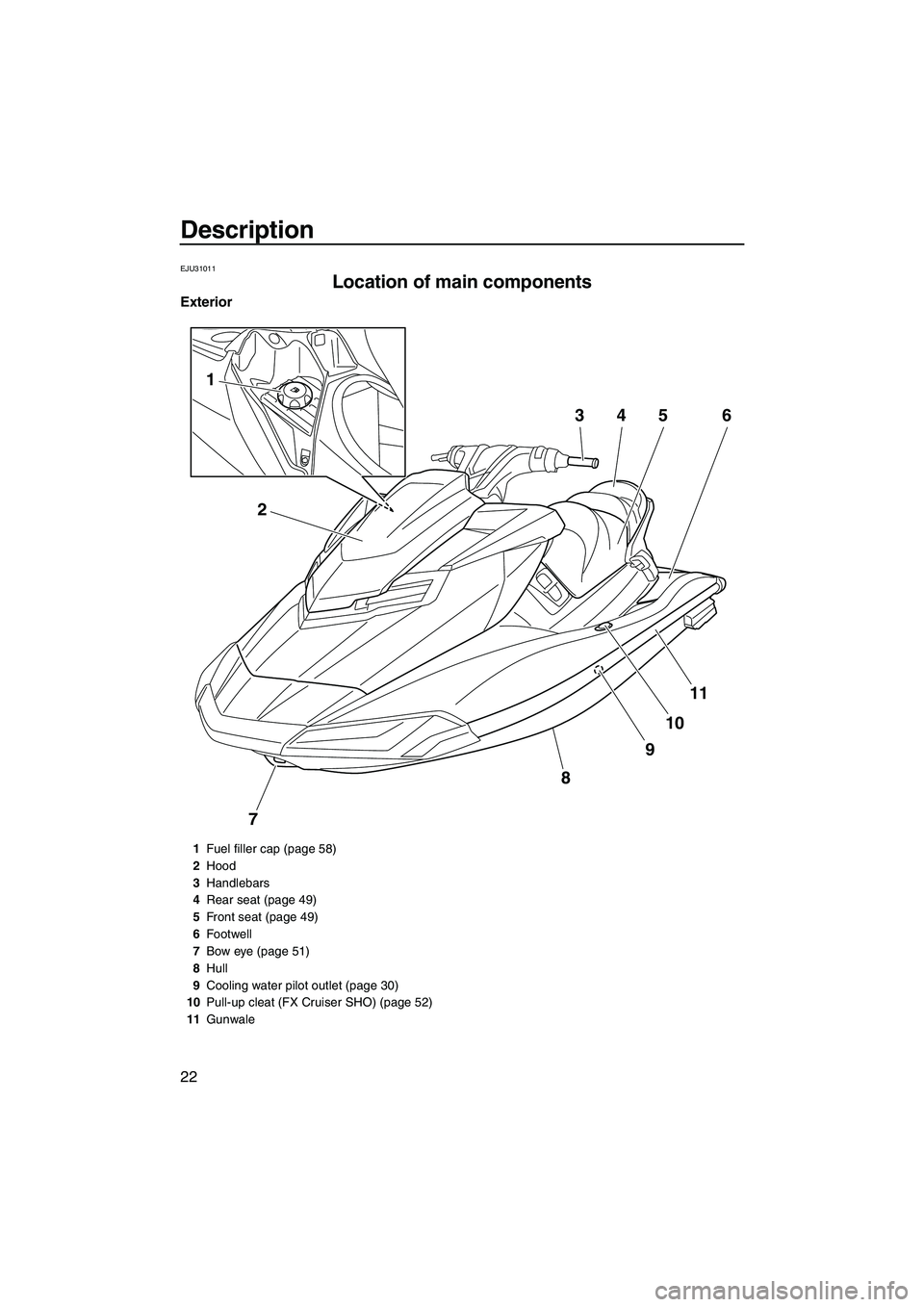
Description
22
EJU31011
Location of main components
Exterior
7
8
9
10
11
2
1
3456
1Fuel filler cap (page 58)
2 Hood
3 Handlebars
4 Rear seat (page 49)
5 Front seat (page 49)
6 Footwell
7 Bow eye (page 51)
8 Hull
9 Cooling water pilot outlet (page 30)
10 Pull-up cleat (FX Cruiser SHO) (page 52)
11 Gunwale
UF2S71E0.book Page 22 Tuesday, August 21, 2012 2:33 PM
Page 31 of 116
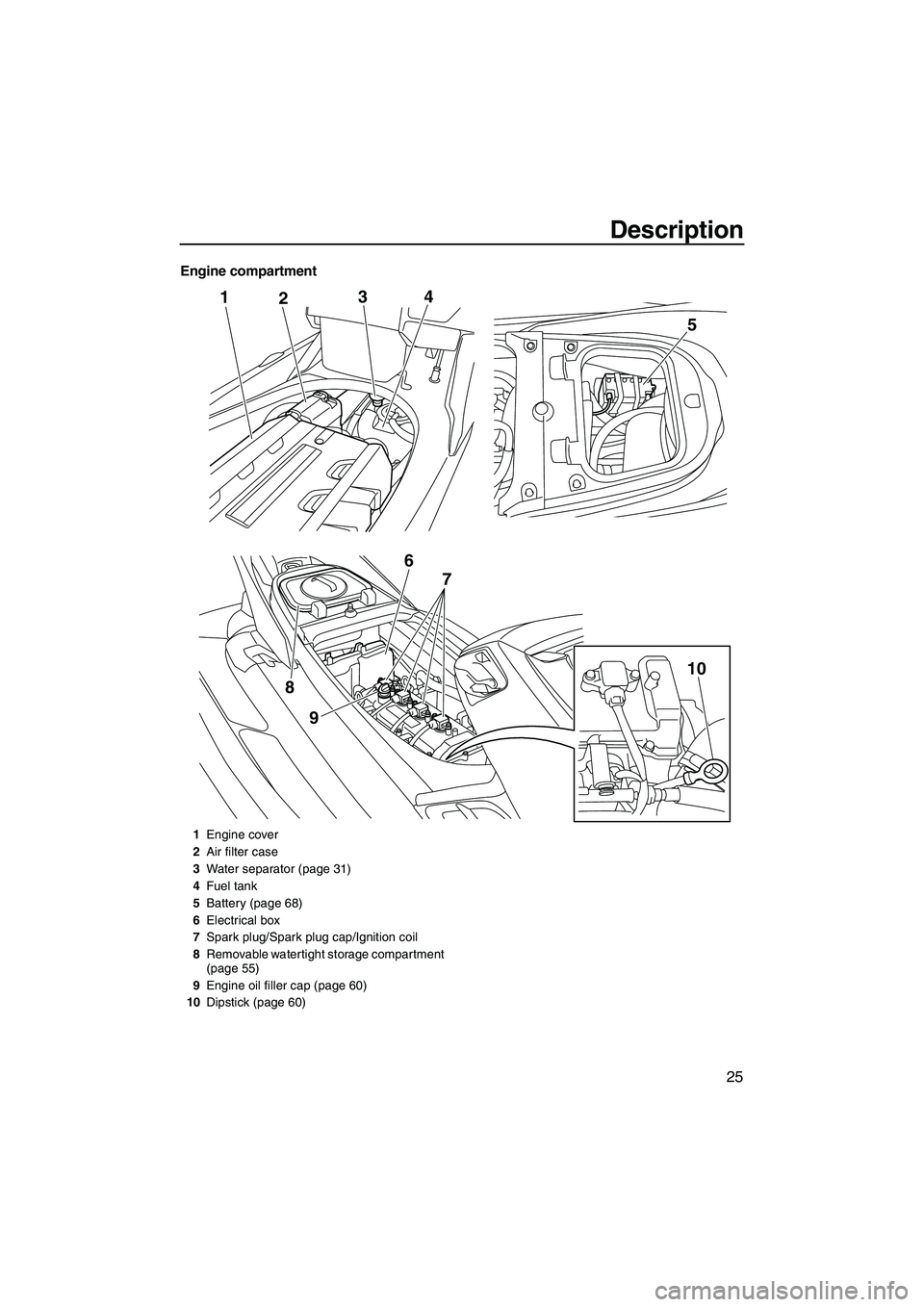
Description
25
Engine compartment
124
9
8
5
3
6 7
10
1Engine cover
2 Air filter case
3 Water separator (page 31)
4 Fuel tank
5 Battery (page 68)
6 Electrical box
7 Spark plug/Spark plug cap/Ignition coil
8 Removable watertight storage compartment
(page 55)
9 Engine oil filler cap (page 60)
10 Dipstick (page 60)
UF2S71E0.book Page 25 Tuesday, August 21, 2012 2:33 PM
Page 37 of 116
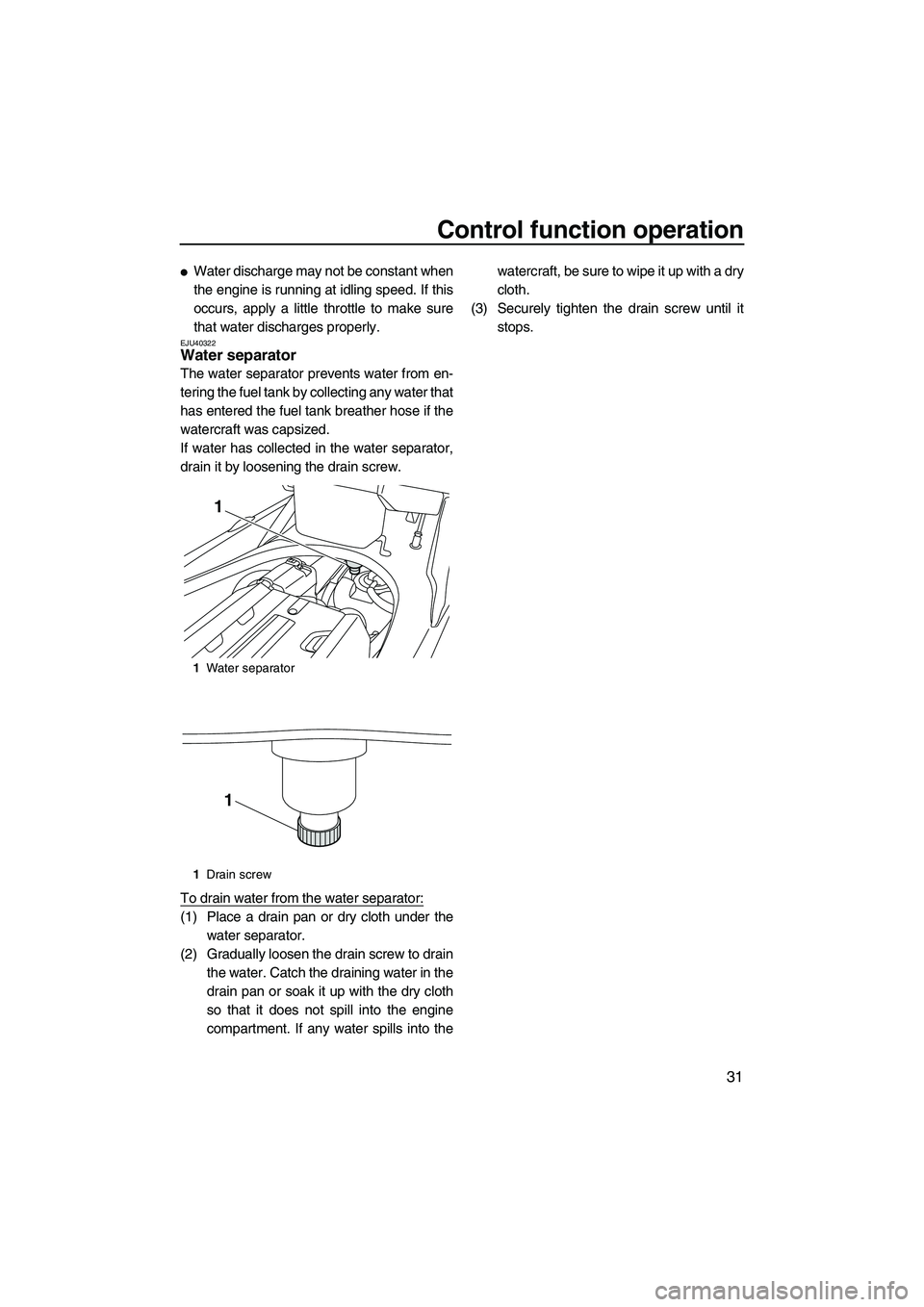
Control function operation
31
●Water discharge may not be constant when
the engine is running at idling speed. If this
occurs, apply a little throttle to make sure
that water discharges properly.
EJU40322Water separator
The water separator prevents water from en-
tering the fuel tank by collecting any water that
has entered the fuel tank breather hose if the
watercraft was capsized.
If water has collected in the water separator,
drain it by loosening the drain screw.
To drain water from the water separator:
(1) Place a drain pan or dry cloth under thewater separator.
(2) Gradually loosen the drain screw to drain the water. Catch the draining water in the
drain pan or soak it up with the dry cloth
so that it does not spill into the engine
compartment. If any water spills into the watercraft, be sure to wipe it up with a dry
cloth.
(3) Securely tighten the drain screw until it stops.
1Water separator
1 Drain screw
1
1
UF2S71E0.book Page 31 Tuesday, August 21, 2012 2:33 PM
Page 65 of 116
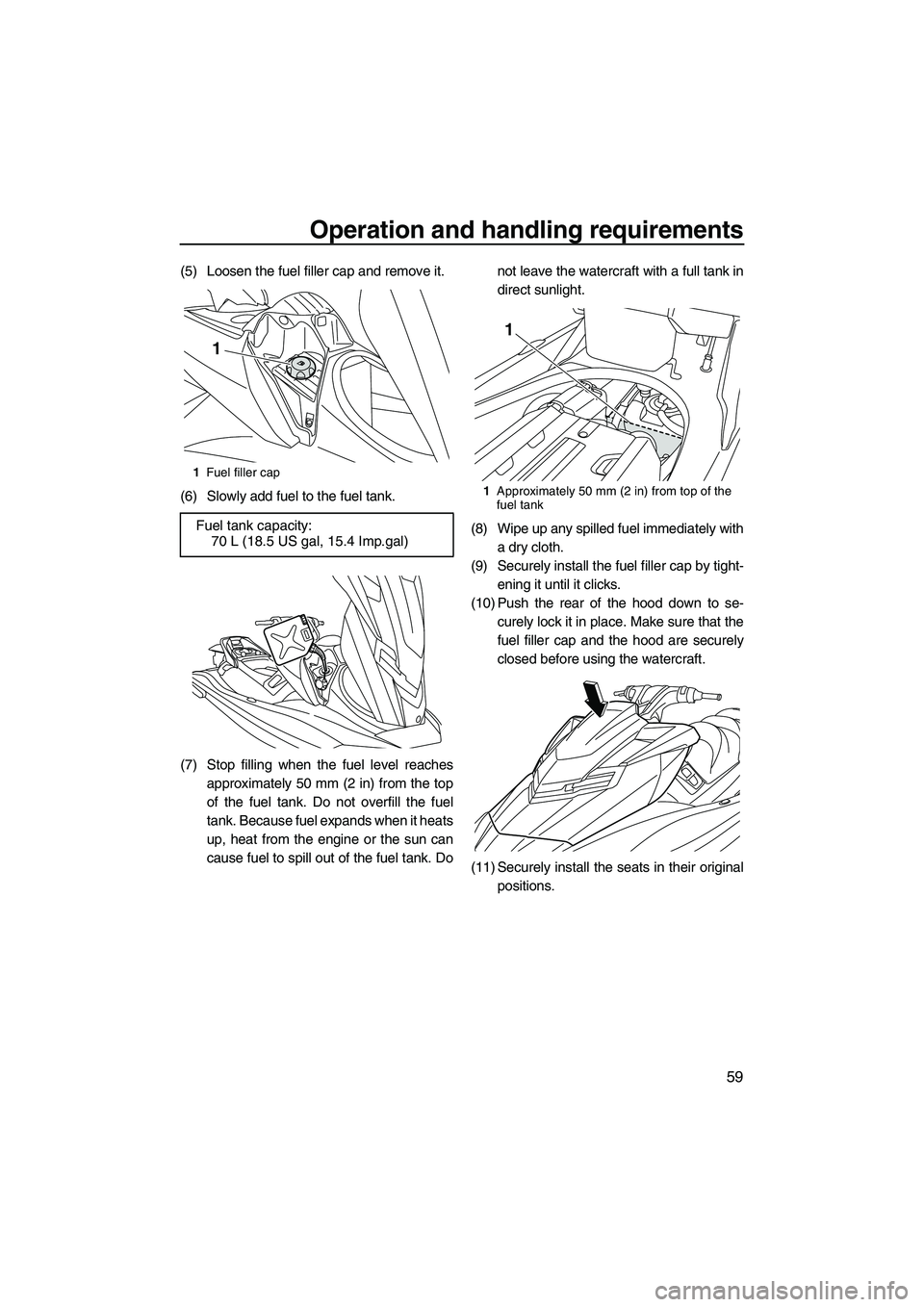
Operation and handling requirements
59
(5) Loosen the fuel filler cap and remove it.
(6) Slowly add fuel to the fuel tank.
(7) Stop filling when the fuel level reachesapproximately 50 mm (2 in) from the top
of the fuel tank. Do not overfill the fuel
tank. Because fuel expands when it heats
up, heat from the engine or the sun can
cause fuel to spill out of the fuel tank. Do not leave the watercraft with a full tank in
direct sunlight.
(8) Wipe up any spilled fuel immediately with a dry cloth.
(9) Securely install the fuel filler cap by tight- ening it until it clicks.
(10) Push the rear of the hood down to se- curely lock it in place. Make sure that the
fuel filler cap and the hood are securely
closed before using the watercraft.
(11) Securely install the seats in their original positions.
1Fuel filler cap
Fuel tank capacity:
70 L (18.5 US gal, 15.4 Imp.gal)
1
1Approximately 50 mm (2 in) from top of the
fuel tank
1
UF2S71E0.book Page 59 Tuesday, August 21, 2012 2:33 PM
Page 73 of 116

Pre-operation checks
67
EJU32281
Pre-operation check points EJU42380Pre-launch checks
Perform the pre-launch checks in the pre-op-
eration checklist while the watercraft is on
land.
To perform the pre-launch checks:
(1) Remove the seats and removable water-tight storage compartment. (See page 49
for seat removal and installation proce-
dures and page 55 for information on the
removable watertight storage compart-
ment.)
(2) Perform the checks and make sure that there are no malfunctioning items or oth-
er problems.
(3) After completing these checks, securely install the removable watertight storage
compartment and seats in their original
positions.
EJU32333Engine compartment check
WARNING
EWJ00461
Failure to ventilate the engine compart-
ment could result in a fire or explosion. Do
not start the engine if there is a fuel leak.
Ventilate the engine compartment. Leave the
engine compartment open for a few minutes
to allow any fuel vapors to escape. Make sure that there is no damage inside the
engine compartment.
EJU34214Fuel system checks
WARNING
EWJ00381
Leaking fuel can result in fire or explosion.
●Check for fuel leakage regularly.
●If any fuel leakage is found, the fuel sys-
tem must be repaired by a qualified me-
chanic. Improper repairs can make the
watercraft unsafe to operate.
Make sure that there is no damage, leakage,
or other problem in the fuel system.
Check:
●Fuel filler cap and seal for damage
●Fuel tank for damage and leakage
●Fuel hoses and joints for damage and leak-
age
●Fuel tank breather hose for damage and
leakage
EJU36874Fuel level check
Check the fuel level in the fuel tank.
Add fuel if necessary. (See page 58 for infor-
mation on filling the fuel tank.)
EJU32423Water separator check
Make sure that no water has collected in the
water separator. If water has collected in the
UF2S71E0.book Page 67 Tuesday, August 21, 2012 2:33 PM
Page 94 of 116
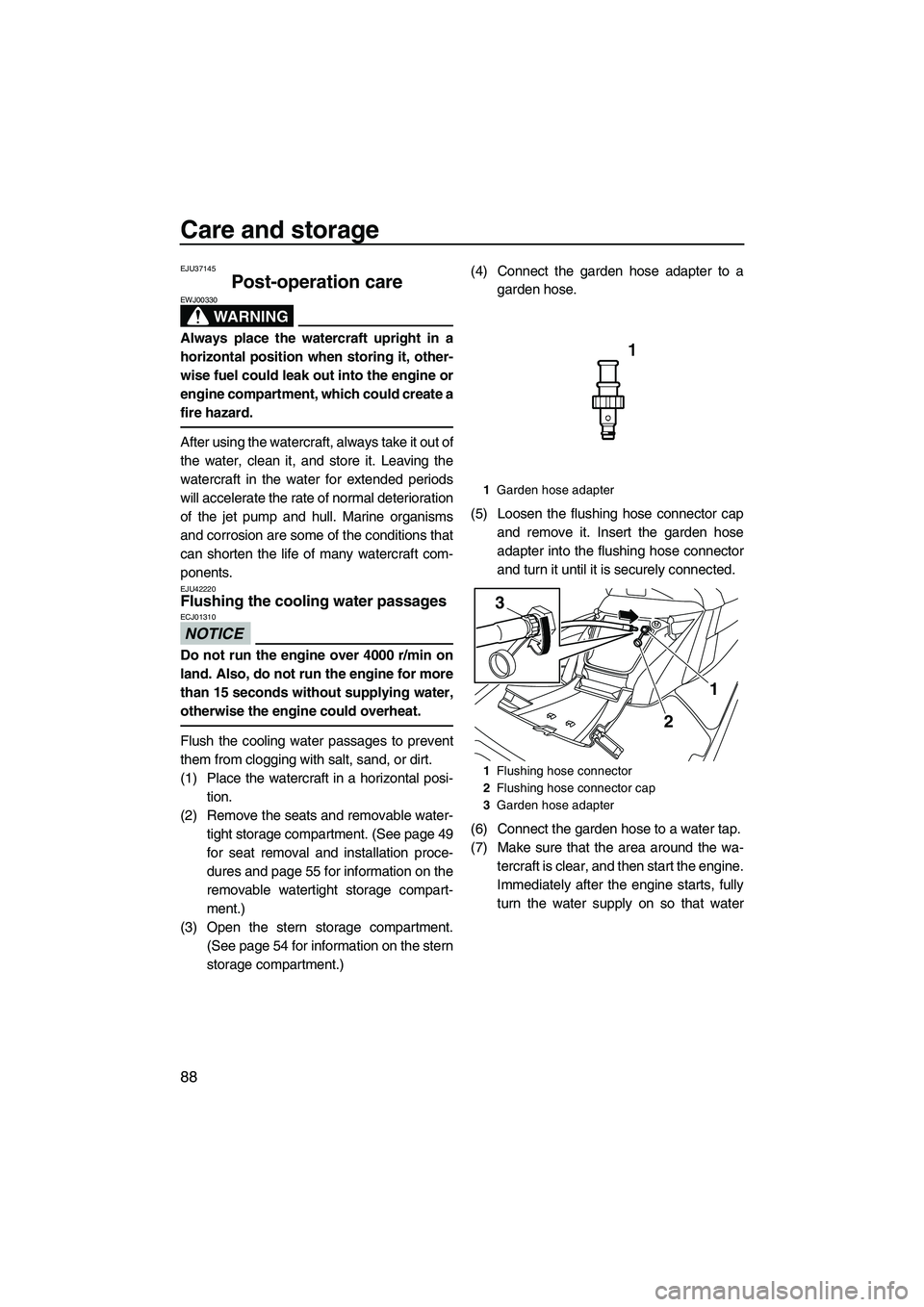
Care and storage
88
EJU37145
Post-operation care
WARNING
EWJ00330
Always place the watercraft upright in a
horizontal position when storing it, other-
wise fuel could leak out into the engine or
engine compartment, which could create a
fire hazard.
After using the watercraft, always take it out of
the water, clean it, and store it. Leaving the
watercraft in the water for extended periods
will accelerate the rate of normal deterioration
of the jet pump and hull. Marine organisms
and corrosion are some of the conditions that
can shorten the life of many watercraft com-
ponents.
EJU42220Flushing the cooling water passages
NOTICE
ECJ01310
Do not run the engine over 4000 r/min on
land. Also, do not run the engine for more
than 15 seconds without supplying water,
otherwise the engine could overheat.
Flush the cooling water passages to prevent
them from clogging with salt, sand, or dirt.
(1) Place the watercraft in a horizontal posi-tion.
(2) Remove the seats and removable water- tight storage compartment. (See page 49
for seat removal and installation proce-
dures and page 55 for information on the
removable watertight storage compart-
ment.)
(3) Open the stern storage compartment. (See page 54 for information on the stern
storage compartment.) (4) Connect the garden hose adapter to a
garden hose.
(5) Loosen the flushing hose connector cap and remove it. Insert the garden hose
adapter into the flushing hose connector
and turn it until it is securely connected.
(6) Connect the garden hose to a water tap.
(7) Make sure that the area around the wa- tercraft is clear, and then start the engine.
Immediately after the engine starts, fully
turn the water supply on so that water
1Garden hose adapter
1 Flushing hose connector
2 Flushing hose connector cap
3 Garden hose adapter
1
3
2
UF2S71E0.book Page 88 Tuesday, August 21, 2012 2:33 PM
Page 104 of 116

Specifications
98
EJU34542
Specifications
Watercraft capacity:
Maximum people on board:3 person
Maximum load capacity: 240 kg (530 lb)
Dimensions:
Length:
3560 mm (140.2 in)
Width: 1230 mm (48.4 in)
Height: 1230 mm (48.4 in)
Dry weight: FX SHO 386 kg (851 lb)
FX Cruiser SHO 387 kg (853 lb)
Performance:
Maximum output (according to ISO 8665/SAE
J1228):154.5 kW@7500 r/min
Maximum fuel consumption:
63.7 L/h (16.8 US gal/h, 14.0 Imp.gal/h)
Cruising range at full throttle: 1.10 hour
Trolling speed: 1250 ±100 r/min
Engine:
Engine type:
Liquid cooled 4-stroke, DOHC
Number of cylinders: 4
Engine displacement:
1812 cm³
Bore & stroke: 86.0 × 78.0 mm (3.39 × 3.07 in)
Compression ratio: 8.6 : 1
Valve clearance-intake (cold):
0.14–0.23 mm (0.0055–0.0091 in)
Valve clearance-exhaust (cold): 0.28–0.37 mm (0.0110–0.0146 in)
Lubrication system: Wet sump
Cooling system:
Water
Starting system: Electric Ignition system:
T.C.I.
Spark plug: LFR6A
Spark plug gap:
0.8–0.9 mm (0.031–0.035 in)
Battery capacity: 12 V, 19 Ah
Charging system: Flywheel magneto
Drive unit:
Propulsion system:Jet pump
Jet pump type: Axial flow, single stage
Impeller rotation: Counterclockwise
Jet thrust nozzle angle:
24.0+24.0 °
Jet thrust nozzle trim angle: -10, -5, 0, 5, 10 °
Fuel and oil:
Recommended fuel:
Regular unleaded gasoline
Minimum octane rating (PON): 86
Minimum octane rating (RON): 90
Recommended engine oil type SAE:
SAE 10W-30, 10W-40, 20W-40, 20W-50
Recommended engine oil grade API: API SE,SF,SG,SH,SJ,SL
Fuel tank total capacity: 70 L (18.5 US gal, 15.4 Imp.gal)
Engine oil quantity with oil filter replacement:
3.1 L (3.28 US qt, 2.73 Imp.qt)
Engine oil quantity without oil filter replacement: 3.0 L (3.17 US qt, 2.64 Imp.qt)
Engine oil total quantity: 4.3 L (4.55 US qt, 3.78 Imp.qt)
UF2S71E0.book Page 98 Tuesday, August 21, 2012 2:33 PM
Page 105 of 116

Trouble recovery
99
EJU34561
Troubleshooting
If you have any trouble with your watercraft, use the troubleshooting chart to check for the pos-
sible cause.
If you cannot find the cause, consult a Yamaha dealer.
EJU42351Troubleshooting chart
Confirm the possible cause and remedy, and then refer to the applicable page.
TROUBLE POSSIBLE CAUSE REMEDYPAGE
Engine does not
start (Starter motor
does not turn over) Yamaha Se-
curity System
Lock mode selected Select unlock mode
27
Engine shut-
off switch Clip not in place Install clip
28
Fuse Burned out Replace fuse and
check wiring 103
Battery Run down Recharge89
Poor terminal con-
nections Tighten as required
89
Terminal corroded Clean or replace 89
Starter motor Faulty Have serviced by
Yamaha dealer —
Engine does not
start (Starter motor
turns over) Throttle lever Squeezed
Release28
Fuel Fuel tank empty Refill as soon as pos-
sible 58
Stale or contaminat-
ed Have serviced by
Yamaha dealer
—
Fuel tank Water or dirt present Have serviced by Yamaha dealer—
Spark plug Fouled or defective Have serviced by Yamaha dealer—
Spark plug
cap Not connected or
loose Have serviced by
Yamaha dealer
—
Connected to wrong
cylinder Have serviced by
Yamaha dealer
—
Fuel injec-
tion system Fuel pump faulty Have serviced by
Yamaha dealer —
Throttle lever Faulty Have serviced by
Yamaha dealer —
UF2S71E0.book Page 99 Tuesday, August 21, 2012 2:33 PM